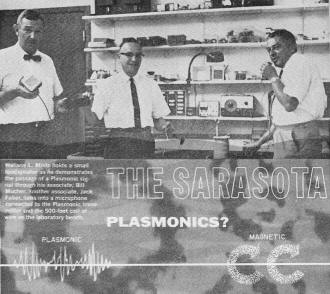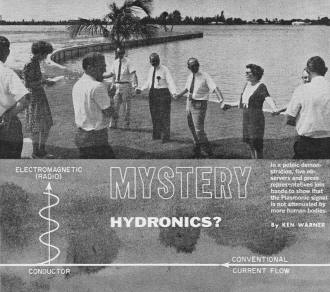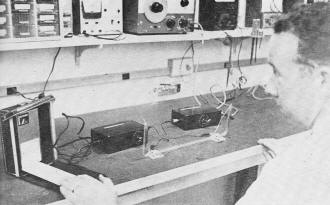The Sarasota MysteryMarch 1966 Popular Electronics |
|
After reading both this article and "The Sarasota Mystery First Follow-Up" article in the April 1966 issue of Popular Electronics, I'm convinced that the inventor Wallace Minto either did not understand the phenomenon he describes, or he's out to punk the reader. If this initial article had been printed in the April issue rather than March, it almost certainly would have to have been a Fool's scam. Minto believes he has discovered a new form of electromagnetic propagation that exploits molecular / atomic properties of water to transmit the signal - without attenuation and without picking up noise. If it sounds too good to be true, it likely isn't. A Google search does not turn up much on hydronics and plasmonics underwater communications, so it's probably safe to assume at this point that the method is either a) ultra top secret military, or b) abandoned as hooey. Here is an article titled, "Wallace Minto Hydronic Radiation Transmitter" in case your curiosity has been piqued. The Sarasota Mystery By Ken Warner Wallace L. Minto holds a small loudspeaker as he demonstrates the passage of a Plasmonic signal through his associate, Bill Mucher. Another associate, Jack Faber, talks into a microphone connected to the Plasmonic transmitter and the 500-foot coil of wire on the laboratory bench. In a public demonstration, five observers and press representatives join hands to show that the Plasmonic signal is not attenuated by more human bodies. If this scientist is right, two new terms (Hydronics and Plasmonics) will be added to the electronics lexicon. Twice, in 1965, a scientist-experimenter named Wallace L. Minto invited observers to a communications demonstration in Sarasota, Florida. On both occasions. the observers left the demonstrations confused, or at least bemused, by what they had seen. According to Minto, a totally new electronic phenomena was being shown: communications via Hydronics and Plasmonics. In the first demonstration, Hydronics enabled "wireless" voice communication from dockside to a scuba diver. The observers also heard the tone signal from a Hydronics transmitter sealed in a buoy and towed through Sarasota Bay. The transmitters were black boxes, but all other equipment (power supplies, microphones, etc.) were commonly available items. The only distinguishable component of unusual size or shape was a dipole antenna fabricated of Monel metal with a spread of about 10 feet. As Minto put the dipole into the Bay, Hydronics signals could be heard; as the antenna emerged, the signals died away. Six months later, Minto held another demonstration, only this time it was of Plasmonics - similar to Hydronics but not requiring the dipole antenna. In place of the antenna, a single wire can be used between transmitter and receiver, or a block of metal, or a body of water, or even the earth itself. Shades of Tesla! Voice transmission via Plasmonics through the single wire was unaffected when the wire was cut and capacitors, resistors (extremely high values), chokes, or even diodes back to back inserted and the "circuit" completed. The observers saw no return circuit, and any time the wire was cut, the Plasmonic signal took a drastic drop in volume. Observers used their own bodies to "conduct" the Plasmonic signal, grasping the end of the wire in one hand and the input terminal of a Plasmonic black box in the other. Additional bodies made no difference in signal strength - as long as they held hands. The small size of the black boxes seemed - to the observers - to eliminate the chance of capacitive coupling as a tentative explanation of the phenomena. Who Is Minto? From the time he entered Columbia University in 1938, Minto has been a respectable maverick in the sciences. Reportedly a brilliant chemistry student, Minto went on the War Production Board in 1942 and the famous Manhattan Project in 1944. Following the end of World War II, he ventured into the commercial world and now lives comfortably on royalties from his patents. He is a member of various professional and scientific societies, and has been called a qualified expert witness by Federal Courts in at least nine different subjects. As far as can be determined, Minto is not particularly oriented toward electronics or radio communications. With a secure reputation, pulling some 50 observers from the U.S. Navy, a dozen large corporations, and a few university labs to Sarasota was no problem to Minto. The demonstrations were obviously impressive, and none of those present offered a conventional explanation of what they had seen and heard. Various press reports were published and cognizance taken of Hydronics in the Proceedings of the Naval Institute. Minto is seemingly a scientist determined to profit from his discoveries. He and his staff will talk about this new wave and its characteristic behavior, but they don't say a word beyond that. Such secrecy is normal in a profit-making venture, although not particularly normal - but absolutely legitimate - for a scientist. Until full defensible patent protection is assured, and until Hydronics, Inc., is satisfied that military security is not involved, Minto and his staff are sitting tight. Using a simple glass tube test rig, Herb Schuessler of Hydronics, Inc., records the transmission spectra of fluids. A sine-wave generator modulates the Plasmonic transmitter (black box at the right) and the signal is propagated down the tube, received by another black box, and the strength recorded. Antennas inserted in the ends of the U-shaped glass tube are made of platinum wire. Below is a typical chart recording of a transmission spectra obtained from this apparatus. Reading from left to right, the audio generator is tuned down from 200,000 to 200 cycles. Plasmonic indications show the "turn on" point to be 21,000 cycles and the main peak response at 1900 cycles. There is a discernible knee at 400 cycles. Enormity of the Discovery. If Plasmonics is a bona fide discovery, the potential is so great as to stagger the imagination. Here are longitudinal waves that travel like sonic waves through water, but at speeds that deny their relationship to sonar. Minto has also demonstrated that various materials possess specific characteristics of transmission of Plasmonics waves at various frequencies. Further proof of this particular effect is claimed by Minto in his tape recording of a Plasmonic signal from the nuclear explosion last October in the Aleutian Islands. Minto and his associates visualize using Plasmonics for standardized spectrum analysis of material in a state of flux - such as molten steel in a crucible. They also look toward the eventual use of Plasmonic hardware to effectively double telephone and telegraphic facilities without stringing more wire. Underwater communication will obviously benefit from the use of Hydronics, and if Minto is only partially correct, the practical aspects of Plasmonics waves are overshadowed by the possibility that these waves may provide information on the missing links between radiation and electron flow. But for the moment, the scene is confusing. Something has been accomplished-but what? Hydronics (Underwater Transmission) From the meager information released by W. L. Minto, plus what observers could deduce, Hydronics has the following properties: Unknown type of radiation (called Plasmonics), similar to radio waves, but only effective under water. Transmissions were interrupted as soon as the antenna was withdrawn from Sarasota Bay. ·Using a dipole antenna, the radiated field pattern is a figure 8, but coaxially aligned with the dipoles, contrary to normal radio wave radiation that would maximize perpendicular to the dipole. Velocity of propagation stated to be "at least" 100,000 miles per second - far above sonar range. Disturbance or agitation of the water has no effect on Hydronics transmissions. Signal strength attenuation said to be according to inverse square law, although one transmission to a distance of 30 miles was claimed. Can Plasmonics Be Discredited? Observers have proposed some of the following tentative pro and con explanations of the Plasmonics phenomenon: Plasmonics are really low frequency (10-20 kc.) radio transmissions: The unexplainable directivity of the dipole antenna seems to refute this. Also, why are the signals stronger out of the water? It should be the other way around. Plasmonics is a close-range lab experiment using simple capacitive coupling: Even capacitive coupling has sensitivity as to distance, so why do the observers need to hold hands to couple the signal between transmitter and receiver? If capacity coupling were involved, the observers wouldn't need to touch one another. Plasmonics is just another gimmicked demonstration: Possibly, but certainly of unbelievable cleverness. Why should a scientist - even as unconventional as Wallace Minto - try to deceive his peers? If it is gimmicked and uses radio waves, one observer tuning from 200 kc. through the FM broadcast band could find no suspicious signals.
Posted March 8, 2018 |
|




